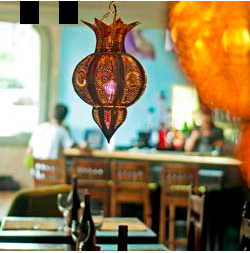Business World Online
 ENTERING THE large, heavy wooden doors of Kasbah one encounters women in colorful beaded and fringed garb which shows off their midriffs; another set of women in skimpy outfits, walking around offering trays and trays of cocktails; and servers pouring you tea from silver teapots — one can’t help but feel like royalty.
ENTERING THE large, heavy wooden doors of Kasbah one encounters women in colorful beaded and fringed garb which shows off their midriffs; another set of women in skimpy outfits, walking around offering trays and trays of cocktails; and servers pouring you tea from silver teapots — one can’t help but feel like royalty.
Delicate lamps light up Kasbah at The Fort Strip.
A “kasbah” (or “casbah”) is, according to Webster’s Third New International Dictionary, “a North African castle or fortress; the area surrounding such a castle or fortress; or a sector containing nightclubs and houses of prostitution.” It is the not surprising name for the newly launched restaurant at the Fort Strip — the younger sibling of a Moroccan restaurant in Boracay — which was the result of the owners’ love for that country.
Madonna English said that her and her husband’s “love affair with Morocco started way back, when we were still doing our importing business in Europe. We started discovering the culture a decade ago… From day one, we always wanted to bring it back here, then we finally opened in Boracay. [The branch] at Fort is the culmination of years and years of trying to set up in Manila. It’s not just any other restaurant but the same one in Boracay.”
The restaurant’s ambiance is sophisticated yet cozy, but the focus is on the authentic Moroccan cuisine.
Moroccan cooking is claimed to be the most refined in North Africa, famed for its couscous and delicately flavored tagines (or tajines, Berber stews cooked in special earthenware pots). Ms. English describes the cuisine as “spicy but will not burn your tongue. A cuisine that has succeeded in marrying the sweet and savory.” Considered one of the most diversified cuisines in the world, it is a mix of Berber-Moorish, European and Mediterranean influences.
As the creator of the menu, Ms. English noted “there’s a good balance of everything [in the menu]. Good balance of meat, seafood and, of course, Moroccan food has a lot of vegetables in their cuisine.”
On the menu is a selection of kemia — cold appetizers served with bread that are usually left on the table to act as side dishes for the main course; salads, like couscous and chickpea, and tabbouleh;brochettes, savory skewers; tagines; soups and entrees.
Ms. English demonstrated the proper way to go through a Moroccan meal — “first, you cleanse your palate with Moroccan tea then proceed to the salad,tagines and finish it off with the tea again. The tea is vital.”
Moroccan tea is a mix of mint leaves, gunpowder tea and sugar. “We’ve tempered the sweetness here,” she noted, “if you want to follow how they do it in Morocco, it’s very sweet.”
Kasbah aims to replicate not only the Moroccan spirit but also Moroccan hospitality. “We want diners to have the same experience as if they were in Morocco. Moroccans are very generous people, like us Filipinos. They go out of their way and treat you like guests, we want the same ambience here.” — Camille Erika R. Sarte
Kasbah is located at the ground floor of the Fort Strip, Bonifacio Global City. It is open from noon to midnight (Sunday to Tuesday), and noon to 1 a.m. (Wednesday to Saturday). For inquiries and reservations, call 218-4021.
.






